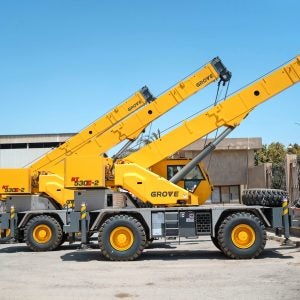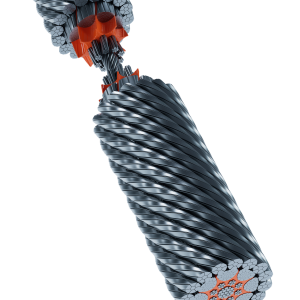New from French tower crane manufacturer Potain is the next model in the Geo range, the MD 208, plus the flat-top MDT 222 and the self-erecting Igo 32. All three will be shown at Bauma in April.
Potain launched its Geo range of top slewing towers at Intermat last year where it exhibited the larger MD 238. Where the MD 238 (B11) had a 12t maximum capacity and could lift 2.8t on the end of a 60m jib, the new MD 208 can lift a maximum 10t, or 2.45t at 60m jib-end. These two cranes, both of which will be at Bauma, replace the MD 235 and MD 205 respectively. (All Geo cranes end in the number eight).
The Geo range is designed to be easy to erect and easy to maintain. To aid assembly and erection, jib and counter jib are assembled on the ground so that only two pre-assembled sections need to be hoisted by mobile crane. Among features designed to reduce maintenance demands is a new hoist rope reeving, combined with a ‘maintenance-free’ fleeting pulley.
High yield point steel in the jib and trolley reduces dead weight and increases capacity. Variable frequency drives on all movements and the new LVF Optima hoisting winch improve productivity by between 40% and 70% depending on loads, Potain says. Another feature is the new-style ‘Vision’ cab.
From its flat-top range, Potain will be showing the MDT 222. Potain has more success with this type of crane in Germany than elsewhere because, since Liebherr has market leadership in the country, it is a niche that Potain has sought out and pursued more assiduously than elsewhere. Potain’s MDT range consists of 13 models from 50tm to 412tm ratings. They became part of the Potain range after it acquired BKT in 1998.
Today, these former BKT models all use Potain K masts and Potain mechanisms, unless otherwise specified (BKT masts and mechanisms are still available). The jibs, cabs and electrical installations are built in the old BKT factory in Arnebourg, Germany. Until this year these cranes used only the old BKT hoist, but now there is the option of Potain’s LVF Optima variable frequency drive hoists, representing a further integration of the BKT cranes into the Potain range. The LVF Optima was launched last year and is claimed to be 70% quicker at hoisting and lowering than former hoists. This is achieved by an electronic unit constantly optimising speed as a function of the load and the direction of the movement.
Potain has also been busy developing its self-erecting range. The first two Igo models, the Igo 15 and the Igo 18, were first seen last October at the SAIE exhibition in Bologna, Italy. Bauma sees the launch of the larger Igo 32, which lifts a maximum 4t, or 1t at the end of the 30m jib – a popular size in Germany, according to Potain. Igo cranes are designed to be movable around construction sites with complete or partial counterweight using either standard Potain transport systems or a semi-trailer. Hydraulic erection cylinders are activated by radio controlled electronic valves. The jib of the Igo is designed to lie flat for transport by folding completely back on itself, with one section wrapping right around the other.
The Igo 15 and 18, as well as planned smaller models can run off a 230V electricity supply as well as 400V. The Igo 32, which replaces the HD 32 in the company’s range, runs off 400V.






